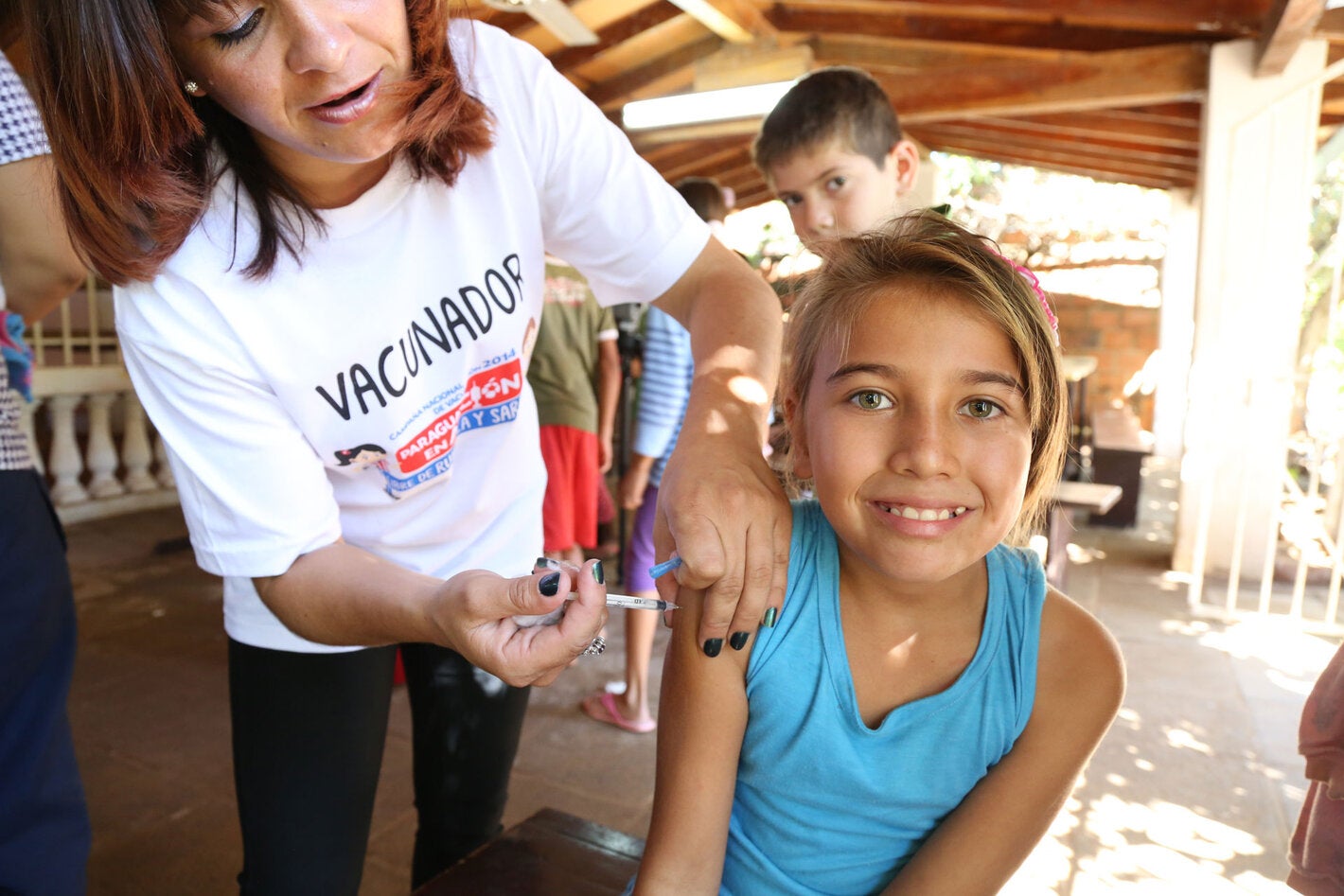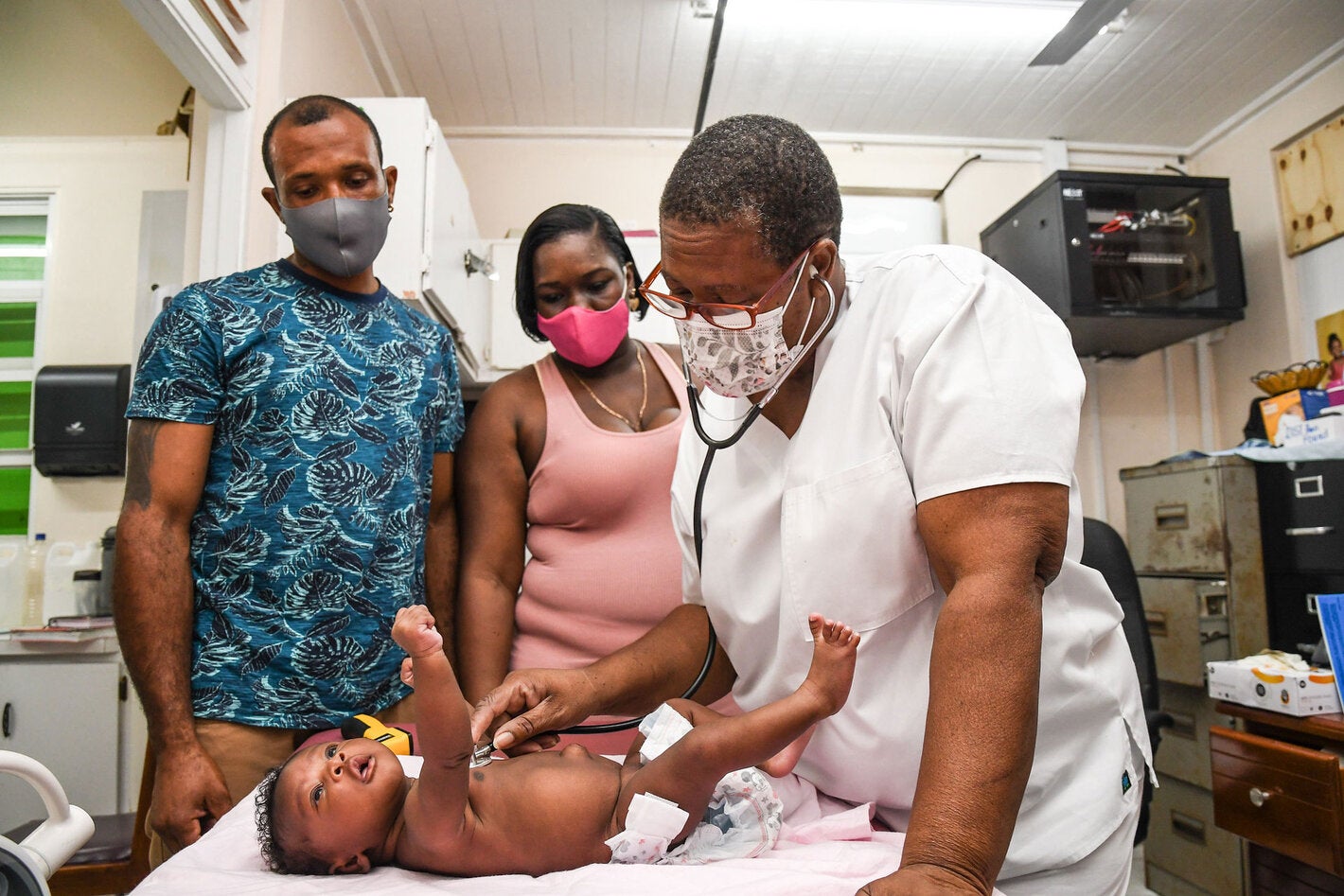Frequently Asked Questions (FAQs) about vaccination from the general public
Vaccine-preventable diseases
No. Diseases such as measles, mumps, rubella, and polio can be prevented by vaccination. It is better to protect yourself through vaccination than by contracting diseases, as infection can cause serious complications in children and adults. Failure to be vaccinated against these diseases leaves us all vulnerable to complications such as pneumonia, brain inflammation, blindness, diarrhea, ear infections, and even death. Vaccination can prevent diseases and their possible complications.
Yes. You should receive all recommended vaccines in your country. Thanks to vaccination, many diseases have become rare or have been eliminated. However, the viruses and bacteria causing them continue to circulate in some parts of the world and do not respect borders. As a result, they can infect anyone who is not protected.
Yes. When schoolchildren are vaccinated, the chance of infection is reduced for all children. However, children are also exposed to many other environments where there may be unvaccinated people, such as parks or libraries, or while traveling. If everyone relied on other people’s children to be vaccinated, there would be many unvaccinated children in the same place. This increases the risk of one infected person spreading a virus or bacteria to multiple people.
Vaccine development and approval
Before being approved for use in the general population, all vaccines undergo three phases of research. This type of research is called a clinical trial. Volunteers are selected to receive the vaccine in each phase of the trial. A team of scientists monitors these people to confirm that the vaccine is safe and to check that it actually protects against disease. The research also allows us to determine which population groups can receive the vaccine, the number of doses, and the time needed between different vaccine doses.
Vaccine clinical trials may be paused to ensure that the vaccine being studied is safe. Measuring vaccine safety is one of the main objectives of investigators. If someone participating in the trial experiences a health event after receiving the vaccine, the study must be paused to investigate whether or not this event is related to the vaccine. Once it is confirmed that the health event is not related to the vaccine, the research can continue.
During a public health emergency, vaccines are evaluated based on the results of clinical trials demonstrating their safety and efficacy (i.e., their ability to protect people against the disease). Manufacturers provide these data to the World Health Organization (WHO), then experts consider whether to include this product on the Emergency Use Listing (EUL).
After carefully evaluating these data, WHO recommends using the vaccine to control and respond to the emergency. The vaccine is not recommended if there are any doubts about its safety or efficacy.
National regulatory agencies (NRAs) in each country analyze the data provided by vaccine manufacturers and consider the EUL approval issued by WHO. Based on these results, each country decides whether to import and administer the vaccine to its population. A country cannot use the vaccine without this national authorization.
Once vaccines are introduced in a country, their efficacy and safety continue to be closely monitored.
Vaccines are only recalled if there is a chance that the vaccine is unsafe. For example, if the manufacturer detects irregularities in some vials of the vaccine, the affected lots could be recalled. In these cases, the national regulatory agency (NRA) and international expert committees analyze the available vaccine safety data, which are constantly being collected before and after the vaccines are used in the general population. If they detect irregularities that could make the vaccine unsafe, the NRA, with the help of the manufacturer, immediately recalls the lots from the country.
Vaccine safety
No. Receiving more than one vaccine at the same time has been shown to have no negative effect on your body’s defenses against infection. There are many advantages to receiving several vaccines at the same time: fewer visits to the clinic; more opportunity to complete the recommended doses on time; and fewer injections when using combined vaccines (e.g., hexavalent diphtheria, tetanus, pertussis, hepatitis B, Hib, and polio vaccine).
Yes. It is important for pregnant women to be vaccinated against influenza, COVID-19, tetanus, pertussis, and hepatitis B to protect themselves and their babies.
Some vaccines should not be given to pregnant women because they contain viruses that have been weakened in a laboratory (such as the chickenpox, measles, or rubella vaccine). However, these vaccines can be administered before pregnancy or after delivery.
If you are pregnant, ask the healthcare staff at your prenatal checkups which vaccines you need and when you should receive them.
Yes. Women who are breastfeeding their babies can be vaccinated since it is safe and has important benefits for their health and the health of their babies. The Pan American Health Organization (PAHO) recommends continuing breastfeeding, even if you receive a vaccine.
Yes. Vaccines exist for different age groups: from birth, childhood, and adolescence, to adulthood. As we age, our body loses its ability to fight infections. Vaccines are useful to help strengthen our defenses, protecting ourselves and those around us.
You can still be vaccinated if you have a mild illness (such as diarrhea or cold symptoms), with or without fever.
However, if you have a moderate or severe illness, caution should be exercised when administering vaccines to avoid confusing the symptoms of the illness with the potential effects of the vaccine. It is important to be vaccinated as soon as possible after recovering from illness.
No. There are no detailed studies demonstrating a relationship between any vaccines and autism or autism spectrum disorders. This belief comes from a study that has already been conclusively disproven and removed from the journal in which it was published. Since then, hundreds of well-designed studies have confirmed that there is no risk of developing autism from vaccination.
No. Vaccines do not contain microchips that allow governments or any other organization to track people.
No. The ingredients in vaccines (such as mercury, aluminum, or formaldehyde) are found naturally in the body, in the food we eat, and in the environment, e.g., in tuna. There are minimal amounts of these ingredients in vaccines and they do not “poison” or harm the body. Vaccines also go through rigorous testing to be certified by the World Health Organization (WHO) and national regulatory agencies (NRAs) in each country. Vaccines offered in public clinics are as safe and effective as those offered in private clinics.
No. Vaccines available to the general public are continuously monitored for potential safety issues. Some people may experience pain at the injection site, mild fever, general discomfort, or rash shortly after vaccination. Although these effects can be uncomfortable, they are not serious and are short-lived, and mean that the body is learning to fight the virus or bacteria.
Sometimes you may need to receive one or more doses of a vaccine for the same disease, manufactured by different brands, to ensure that you receive all recommended doses.
You will only receive different brands of vaccine when scientific studies and recommendations prove that this is safe and produces a similar or higher level of defense than using the same brand.
No. Sudden infant death syndrome is when an infant aged between one month and one year old dies suddenly, for no obvious reason, even after a thorough investigation. There is no scientific evidence that vaccines are associated with cases of this syndrome.
No. There is no scientific evidence that vaccination reduces your ability to have children naturally.
No. Surgery is not a reason to postpone vaccination. Similarly, recent vaccination is not a reason to postpone surgery.
No. Vaccines do not contain fetal tissue cells. Some vaccines have been developed using laboratory-grown cells from tissue obtained from voluntary abortions. These abortions were legal in the countries where they were performed. The advantage of these laboratory-grown cells is that they can be endlessly multiplied under certain conditions in a scientific laboratory and used during vaccine research. No vaccines available to the public contain fetal cells.
Sometimes you may experience a change in health status (e.g., a symptom, a change in test results, some discomfort) after receiving a vaccine. This change may or may not be related to the vaccine. With the support of the Pan American Health Organization (PAHO), countries have developed surveillance systems to investigate any events occurring after vaccination (regardless of whether or not they are related to the vaccine). Experts review and analyze the data, and provide a rapid response when needed.
Vaccine efficacy
Vaccines activate the body’s natural defenses, so that they learn to resist certain infections. They are a simple and effective way to protect ourselves against diseases caused by viruses or bacteria before we come into contact with them.
Full protection from a vaccine begins a few days after receiving it. The highest estimated protection is achieved after receiving all recommended vaccines. You can get a disease immediately before or shortly after receiving a vaccine.
No. Your immune system produces antibodies against viruses or bacteria when it comes into contact with them, whether this is naturally or after receiving a vaccine. Being vaccinated against one disease does not weaken your body’s defenses against another disease.
Each country’s immunization program recommends certain vaccines. These vaccines vary depending on the most common diseases in your country, your age, lifestyle, and job. To find out which vaccines are recommended for you, visit the Ministry of Health website or ask the staff at your healthcare facility.
All countries provide vaccination cards recording which vaccines you have received and which ones you should receive at a later date. We should all make sure that our vaccines are up to date.
Yes. To strengthen the response of your body’s defense system, it is important to receive the recommended number of doses, including booster doses, within the indicated time period. Failure to receive this extra dose means that you are not fully protected against the disease.
No. Vaccines create defenses without the potential harmful effects of disease, including long-lasting effects and death. Allowing diseases to spread could cause millions of deaths and cause even more people to live with the long-lasting effects of viruses.
Vaccination and international travel
International travelers should follow the health requirements published by the countries to which they are traveling. It is important to receive all required doses well in advance of travel to avoid transmitting or contracting diseases in the destination countries. To find out which vaccines and how many doses you should receive, speak to your healthcare provider and visit the Ministry of Health website of the country you are visiting.
Sources of information on vaccines
Updated information on all vaccines can be found on the World Health Organization (WHO) and Pan American Health Organization (PAHO) websites. You can also find out about all vaccines offered in a country on the Ministry of Health website and from your healthcare provider.
To ensure that information is reliable, you can follow the steps below:
- Evaluate the source of information: Does it say who created it? If so, are the authors of the information real and trustworthy? When looking at social media, check for fake accounts, how long they have been active, and whether they collect facts rather than express an opinion. When looking at websites, check the “About Us” and “Contact Us” sections for general information and more details about the website. Poor spelling and grammar and an unprofessional layout are other signs that the creator of the information may not be reliable.
- Look beyond the headlines: Headlines are often written in a sensational or provocative tone, to get a large number of clicks (click-bait). We recommend reading the entire article to get the full context and understand the meaning behind the headline. You should also look for similar information on other platforms: do not just rely on social media. By accessing a variety of sources, you have a clearer idea of what information is reliable and what is not.
- Check the date: We recommend making sure that the information you are reading is up to date, as situations and research evolve. Recently published information will contain the most accurate data, taking into account the facts and recent scientific information.
- Look at the scientific data supporting the information: Credible sources back up their claims or opinions with data and include links to them. That way, anyone can access the facts independently.
Frequently Asked Questions (FAQs) about vaccination from vaccination workers
Programming
Vaccination schedules are established based on clinical trials. The time between doses (vaccination interval) in clinical trials usually becomes the recommended time for the vaccination schedule. A minimum interval is the shortest time between two doses in a vaccine series for which we can expect an adequate response. We recommend that vaccine doses be administered according to the times recommended in the manufacturer’s information leaflet.
For routinely administered vaccines, it is not necessary to restart the vaccine series if the interval between doses ends up being longer than recommended. In certain circumstances, the oral typhoid vaccine (which may be given to international travelers) should be restarted if the vaccine series has not been completed within the recommended time period.
It is essential that you do not postpone any recommended vaccines. There is no limit to the number of vaccines that can be administered during a single visit. When administering multiple injections at once, we recommend keeping the injection sites of intramuscular vaccines at least 1 inch (2.5 cm) apart to reduce the likelihood of overlapping local reactions. It may be convenient for most people to receive all recommended vaccine doses during a single visit, so it is important to offer and co-administer vaccines when recommended.
Precautions and contraindications
Patients with a mild acute illness (such as diarrhea or mild upper respiratory tract infection), with or without fever, can still be vaccinated.
However, if a patient has a moderate or severe acute illness, caution should be exercised when administering vaccines to avoid confusing the symptoms of the illness with the potential effects of the vaccine. It is important to vaccinate patients as soon as possible after recovering from acute illness.
No. Recent tattoos or piercings can sometimes cause local inflammation, but this should not be a reason to delay or suspend vaccination. However, if the tattoo or piercing has caused a general opportunistic infection, vaccination should be postponed until the acute condition has improved. Hepatitis B vaccination is recommended if the patient has not been immunized before getting a tattoo or body piercing.
Vaccine administration
Vaccines should always be administered by the route recommended by the manufacturer. However, if a vaccine is administered by the incorrect route, the Pan American Health Organization (PAHO) recommends that it be considered valid. The only exceptions are the hepatitis B and rabies vaccines, which, if administered by any route other than intramuscular, should not be considered valid and should be administered again by the correct route.
No. Current guidance does not require healthcare workers to wear gloves when administering vaccines, unless they are likely to come into contact with body fluids that could be infectious or have an open wound on their hand. If you choose to wear gloves, new gloves should be used for each patient.
No. Vaccine diluents are not interchangeable.
No. The Pan American Health Organization advises against the practice of preloading vaccines into syringes due to the increased risk of administration and dosing errors. Another reason to discourage this practice is that some vaccines have a very limited shelf life after reconstitution. The syringe should be prepared at the time the vaccine is administered.
No. Aspiration (pulling back on the syringe plunger once the needle is in the arm before injecting to check for blood return) is not recommended when administering vaccines. Intramuscular injections are not administered in areas where there are large vessels. Given the size of the needle and the angle at which the vaccine dose is injected, it is very difficult to administer the vaccine intravenously.
Patients with pre-existing comorbidities
Yes. Antibiotic treatment is not a valid reason to postpone vaccination. If a child or adult patient is well or has only a mild illness, vaccines should be administered. However, if a patient has a moderate or severe acute illness (regardless of the use of antibiotics), vaccination should be postponed until his or her condition has improved.
Intramuscular injections should be scheduled shortly after treatment for hemophilia or before receiving a dose of anticoagulant. A fine needle (23 gauge or smaller) should be used for both intramuscular and subcutaneous injections and firm pressure should be applied to the site, without rubbing, for at least two minutes.
Healthcare workers should not administer a vaccine by a route that is not approved for that particular vaccine (e.g., administering intramuscular vaccines subcutaneously).
No. Children with Down syndrome are often at greater risk of complications from vaccine-preventable diseases than other children. Therefore, children with Down syndrome should receive all recommended vaccines in the vaccination schedule.
It depends on each patient’s treatment and the type of vaccine.
- Steroid therapies that are short-term (less than two weeks), involve administration on alternate days, include physiologic replacement, are topical (skin or eyes), inhaled, or are given by intra-articular, bursal, or tendon injection are not considered contraindications to the use of live virus vaccines.
- The immunosuppressive effects of corticosteroid treatment vary. A dose equivalent to 2 mg/kg body weight or a total of 20 mg per day of prednisone for two or more weeks is sometimes considered by healthcare workers to be sufficiently immunosuppressive to raise concerns about the safety of vaccination with live virus vaccines (e.g., MMR, chickenpox, yellow fever). Healthcare workers should wait at least one month after treatment discontinuation or dose reduction before administering a live virus vaccine to patients who have received high doses of systemically absorbed corticosteroids for two or more weeks.
- Inactivated and toxoid vaccines can be administered to all immunocompromised patients at the usual doses and schedules, although the response to these vaccines may be lower than usual.
Vaccine development and approval
Before being approved for use in the general population, all vaccines undergo three phases of research. This type of research is called a clinical trial. Volunteers are selected to receive the vaccine in each phase of the trial. A team of scientists monitors these people to confirm that the vaccine is safe and to check that it actually protects against disease. The research also allows us to determine which population groups can receive the vaccine, the number of doses required, and the interval needed between different vaccine doses.
Vaccine clinical trials may be paused to ensure that the vaccine being studied is safe. Measuring vaccine safety is one of the main objectives of investigators. If someone participating in the trial experiences a health event after receiving the vaccine, the study must be paused to investigate whether or not this event is related to the vaccination. Once it is confirmed that the health event is not related to the vaccine, the research can continue.
During a public health emergency, vaccines are evaluated based on the results of clinical trials demonstrating their safety and efficacy (i.e., their ability to protect people against the disease). Manufacturers provide these data to the World Health Organization (WHO), then experts consider whether to include this product on the Organization’s Emergency Use Listing (EUL).
After carefully evaluating these data, WHO recommends using the vaccine to control and respond to the emergency. The vaccine is not recommended if there are any doubts about its safety or efficacy.
National regulatory agencies (NRAs) analyze the data provided by vaccine manufacturers and consider the EUL approval issued by WHO. Based on these results, each country decides whether to import and administer the vaccine to its population. A country cannot use the vaccine without this national authorization.
Once vaccines are introduced in a country, their efficacy and safety continue to be closely monitored.
Vaccines are only recalled if there is a chance that the vaccine is unsafe. For example, if the manufacturer detects irregularities in some vials of the vaccine, the affected lots could be recalled. In these cases, the national regulatory agency (NRA) and international expert committees analyze the available vaccine safety data, which are constantly being collected before and after the vaccines are used in the general population. If they detect irregularities that could make the vaccine unsafe, the NRA, with the help of the manufacturer, immediately recalls the lots from the country.







